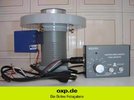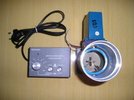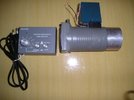Trust
Specialist Contributor
- Joined
- Jul 18, 2004
- Messages
- 1,137
- Reaction score
- 1,621
- Points
- 113
- Age
- 78
- My Satellite Setup
- 1.8 m CM at SMR 1224 + Elev. with 7 lnb changer Ku (lin - circ) - Ka (lin - circ) C (lin - circ)
- My Location
- Nijmegen Netherlands
I found a picture on the net from that Docrato C band lnb . http://www.bandaku.com.br/docrato.html
The servo attached to it makes it possible to switch between Lin. and Circ. without losses at Lin.
Allready tried to mail the company , but it seems they dont exist anymore . (returned message)
Is anyone familiar with that device , like to see more pictures from it .

In the C-band satellites listed below and that have their signals on Brazil, I-705, NSS-806, NSS-7, I-905, I-707, I-903, I-801, I-907 and I-10-2, will be found transmission of FTA digital channels and feeds streams with circularly polarized signals to the left and right. For your reception, you must use in the dish, a single point linear feeder, for example type LNBF, with adaptation for circular depolarization. For this, it uses existing feeders to add a fixed device, typically a dielectric plate when no pins, screws or stepped septum. Feeders well adapted, all of them are static and can not be efficient enough to receive all circular channels. And when he goes to a satellite whose transmission is linear polarization, horizontal or vertical orientation, you must go to the roof, remove the plate from the LNBF LNBF or even change the type feeder, replacing it with another without adaptation, in If he was not removable. It would not be so often occurs with many installed systems?
Now, all this trouble may be coming to an end. It developed a new depolarizing device, not known in the prior art, which will adapted feeders type LNBF, as others are, but with a key difference: it can be triggered in operating time.It has the property to commute in LNBF type feeder, linear polarity state to circular and vice versa, returning the circular polarity state to linear. Thus, it is not necessary to change 0 feeder, when going from a satellite whose transmission is in linear polarization to another whose transmission is in circular polarization. All this is done remotely, using an adapted LNBF, with its innovative device, triggered by skew due to its receptor or if it does not have this role, through a stand-alone module skew that can be supplied both to drive the switching device, such as the polarization adjustment, to better marry her right or left. All this without losses in linear function of the LNBF.
Remote adjustment, operating time, for better selectivity of circular channels is the other key difference, comparing it with existing devices. Since it can be adjusted, you will act on it in operation time, to better adjust the orientation of the polarity between the left and right, and even more, the user can, through this adjustment potentiometer, or otherwise, promote and selective fine-tuning of the most critical digital channels to be discriminated against, especially the FEC 5/6 and 7/8.
Using a novel design, not known in the prior art, it was possible to build a circular wave depolarizing remotely adjustable operation time, which was assigned the acronym DOCRATO. The work on the device operating time allows switching and setting, by adjusting, be shall be promoting best wave phase matching, better impedance matching and minimizing the standing wave ratio at any tuned frequency, which is not enabled, operating time in the depolarizing other devices adapted feeders type LNBF.
The servo attached to it makes it possible to switch between Lin. and Circ. without losses at Lin.
Allready tried to mail the company , but it seems they dont exist anymore . (returned message)
Is anyone familiar with that device , like to see more pictures from it .

In the C-band satellites listed below and that have their signals on Brazil, I-705, NSS-806, NSS-7, I-905, I-707, I-903, I-801, I-907 and I-10-2, will be found transmission of FTA digital channels and feeds streams with circularly polarized signals to the left and right. For your reception, you must use in the dish, a single point linear feeder, for example type LNBF, with adaptation for circular depolarization. For this, it uses existing feeders to add a fixed device, typically a dielectric plate when no pins, screws or stepped septum. Feeders well adapted, all of them are static and can not be efficient enough to receive all circular channels. And when he goes to a satellite whose transmission is linear polarization, horizontal or vertical orientation, you must go to the roof, remove the plate from the LNBF LNBF or even change the type feeder, replacing it with another without adaptation, in If he was not removable. It would not be so often occurs with many installed systems?
Now, all this trouble may be coming to an end. It developed a new depolarizing device, not known in the prior art, which will adapted feeders type LNBF, as others are, but with a key difference: it can be triggered in operating time.It has the property to commute in LNBF type feeder, linear polarity state to circular and vice versa, returning the circular polarity state to linear. Thus, it is not necessary to change 0 feeder, when going from a satellite whose transmission is in linear polarization to another whose transmission is in circular polarization. All this is done remotely, using an adapted LNBF, with its innovative device, triggered by skew due to its receptor or if it does not have this role, through a stand-alone module skew that can be supplied both to drive the switching device, such as the polarization adjustment, to better marry her right or left. All this without losses in linear function of the LNBF.
Remote adjustment, operating time, for better selectivity of circular channels is the other key difference, comparing it with existing devices. Since it can be adjusted, you will act on it in operation time, to better adjust the orientation of the polarity between the left and right, and even more, the user can, through this adjustment potentiometer, or otherwise, promote and selective fine-tuning of the most critical digital channels to be discriminated against, especially the FEC 5/6 and 7/8.
Using a novel design, not known in the prior art, it was possible to build a circular wave depolarizing remotely adjustable operation time, which was assigned the acronym DOCRATO. The work on the device operating time allows switching and setting, by adjusting, be shall be promoting best wave phase matching, better impedance matching and minimizing the standing wave ratio at any tuned frequency, which is not enabled, operating time in the depolarizing other devices adapted feeders type LNBF.


